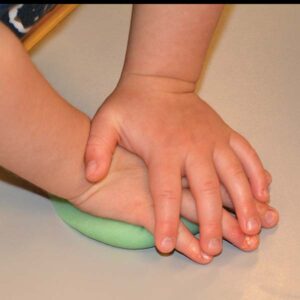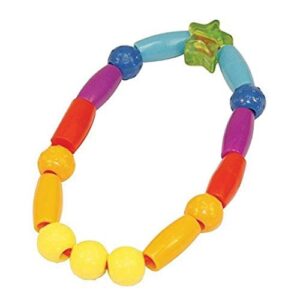Problem-solving, Object inquiry skills
Toddlers make one play dough creation for each of their two hands.

Play dough (see Be Prepared)


Be Prepared: Prepare one three-inch ball of play dough (about the size of an orange) for each toddler.
 Invite several toddlers to a clean and clear table to use play dough. Toddlers may sit or stand at the table. Show one ball of play dough. Explain that we will use our hands to create whatever we want with our ball of play dough.
Invite several toddlers to a clean and clear table to use play dough. Toddlers may sit or stand at the table. Show one ball of play dough. Explain that we will use our hands to create whatever we want with our ball of play dough.
We want to make one creation for each of our hands. This means we will make two creations. We will make one creation to hold in one hand and one creation to hold in our other hand. Demonstrate the idea of making something to hold in each hand by extending one arm with an open hand when you make reference to “one hand” and extending your other arm with an open hand when you make reference to “our other hand.” When we are done, each of our hands will hold one creation.
Give each child one ball of play dough. Demonstrate a way to break a ball of play dough into two parts. You may wish to pull off a chunk of the dough into a second collection of dough. Or you may wish to partly flatten the ball and then push a hand sideways through the middle of the dough to begin a separation of the ball into two parts. The two parts do not need to be equal in size. Encourage toddlers to break their ball of play dough into two parts using whatever approach they would like. Figuring out how to form two collections of dough from one ball of play dough is an interesting problem for each toddler to solve. Provide assistance as needed. It is beneficial for toddlers’ sensory learning to use their hands for this task. Refrain from offering tools for breaking the ball into two parts.
Support toddlers in making two creations from their one ball of play dough, one creation at a time. Explain that we are changing the ball of play dough into something different. It is no longer one ball of dough. Demonstrate some ways to shape the dough if toddlers seem to need ideas of what to do. Examples: Roll a chunk of dough back and forth to create a hot dog shape. Roll a small amount of dough into a ball using both hands. Encourage different types of creations. Describe toddlers’ actions. Use descriptive words, such as flatten, roll, and push. You may wish to show how to press a thumb or finger(s) into a flattened or small ball of dough to make a design.
When toddlers have finished (or nearly finished) their creations, invite them to hold their creations in their hands: one creation in one hand, the other creation in the other hand. Demonstrate by extending both of your arms, with palms of each hand facing up. Help each toddler hold both of their creations, one per hand.
Look for ways to emphasize the activity’s three primary opportunities for toddlers to consider the idea of making one creation for each of their two hands: (1) when toddlers change their one ball of play dough into two chunks of dough; (2) when toddlers work on one of their two creations at a time; and (3) at the end of the activity when toddlers hold one creation in each of their two hands. These opportunities support development of an early awareness of one-to-one correspondence. This important math understanding should not be formally taught during the toddler years, but it can be informally introduced through activities, such as the one offered in this option. Be especially careful to not skip the third opportunity (when toddlers hold a creation in each hand). In a similar way, the concepts of one and two can be informally mentioned during the activity (most toddlers are familiar with the words one and two from telling how old they are) but should not be formally taught at this age.
Extra support
Enrichment
Invite toddlers to describe how they made their creations. (Note: this suggestion is different than asking toddlers to describe what they made.)
Problem-solving
Toddlers make one pretend play dough treat for each of three bear counters.


One

Be Prepared: Prepare one three-inch ball of play dough (about the size of an orange) for each toddler.
[Invite several toddlers to join you at a low table to play in a pretend bakery.]
Today we can pretend we work in a teddy bear bakery. At our bakery, we use play dough to make treats for teddy bears. Each of us will have three bear counters. We can make one treat for each of the teddy bears.
[Give each toddler three bear counters, preferably in different colors, and one ball of play dough. Encourage toddlers to put their bear counters in a line toward the top part of their workspace, and leave space in front to make things for our bears.
Invite toddlers to talk about what is made at a bakery. If necessary, describe some things toddlers could make, such as muffins and bread. Connect the bakery or bakery items to baked goods served at your center and/or a book sharing about a bakery, if possible.
Emphasize that we can make what we want. We can bake a different item for each bear, such as a muffin for one bear and a slice of bread (toast) for another bear. Or we can make the same thing for each of our bears.
Allow ample time for the toddlers to use the dough as they like. Talk with each toddler about what he/she is doing with the dough. Example: “Aaron, I see you are pulling small pieces from your big ball of dough.”
Playfully animate one of your counting bears. Example: “Here is a bakery. I wonder if the baker has a yummy muffin for me. I am really hungry!”
Encourage toddlers to place one of their baked items next to each bear. Encourage toddlers to describe (or you describe) what they are giving each bear. Example of your description: “I think this bear got a muffin. I think this other bear got a roll.” It is fine if toddlers have leftover dough.]
We pretended to work in a bakery. We were bakers! We baked one thing for each of our bears. Do you think the bears will enjoy eating the pretend things we baked?
If you notice a toddler has more or fewer pretend bakery items than bears, help the toddler line up his/her bears and place one available item in front of each bear. Talk about the situation. Examples: “This bear doesn’t have anything to eat from our bakery. What can we do?” “Each bear has a muffin. And you have one muffin left over. What would you like to do with this leftover muffin?”
Toddlers often want to do activities their own way. Some toddlers may wish to make a hot dog, taco, or ice cream for each counting bear. Flexibility with what is made with the play dough is important. The activity goal is to prepare one item for each bear.
After making one item for each bear, toddlers may wish to repeat the activity, make more items for more bears (see Enrichment tip), or play with the dough in another way.
Extra support
Enrichment
Problem-solving
A toddler distributes one of several different items to each of five monkey puppets.




Five Little Monkeys Jumping on the Bed by Eileen Christelow
Be Prepared: Place the following in the basket: finger puppets, teething beads, and cubes (five of each).
Invite one toddler to join you to play with five monkey puppets. Sit facing the toddler and lay the felt squares in a line in front of the toddler. Explain that the pieces of felt are pretend blankets. We are going to put a toy monkey and other things for a monkey on each of the pretend blankets.
 Give the toddler a basket containing the monkey finger puppets, the teething beads, and five wooden cubes. Explain that the toddler can put one of each item on each of the pretend blankets. Begin with the monkey puppet. After there is one monkey puppet on each pretend blanket, invite the toddler to select another item to put on each pretend blanket. Proceed by item. Example: Each blanket gets a wooden cube. Remind the toddler that each blanket/monkey gets one.
Give the toddler a basket containing the monkey finger puppets, the teething beads, and five wooden cubes. Explain that the toddler can put one of each item on each of the pretend blankets. Begin with the monkey puppet. After there is one monkey puppet on each pretend blanket, invite the toddler to select another item to put on each pretend blanket. Proceed by item. Example: Each blanket gets a wooden cube. Remind the toddler that each blanket/monkey gets one.
Promote a back-and-forth conversation with the toddler about how the monkey might use the items. Example: A toddler may pretend the wooden cube is a lunch box or food or a bed. Invite the toddler to arrange each monkey’s items as he/she wishes. Example: The toddler may use the pretend blanket to cover the monkey rather than as something for the monkey to lie on.
Conclude the activity by emphasizing that the toddler put one type of thing on each blanket for a monkey.
Look at the ease with which the toddler distributes items (some toddlers may want to look and think before acting) and offer guidance, as appropriate, without directing the distribution of items. See the Extra Support tip for reducing the challenge of the activity. Like Options 1 and 2, this activity promotes the development of awareness of one-to-one correspondence without teaching this concept.
Extra support
Omit one of the items (such as the wooden cube) or create fewer groupings (three to four instead of five) if you anticipate distributing three items across five groupings will be too challenging.
Enrichment
If a toddler wants more, provide one of each item, so there are always the same number of monkeys as other play materials.
Materials Needed: trays with dividers, pretend food, small boxes (such as mailing boxes) vehicles, cups, monkey finger puppets, dollhouse, people figures
Toddlers enjoy putting items in trays with dividers. Place trays that will hold pretend food in the dramatic area. Place small boxes in the block area with vehicles that will fit into each. Mailing boxes can be used as garages, or you may have garages at your center. Encourage toddlers to put one cup next to each plate at the dramatic play table. Use the monkey finger puppets in the dollhouse (in place of people figures), with props the toddlers can divide five or fewer ways.
Materials Needed: 6 toys or balls, muffin pan, small felt squares, musical instruments, box of markers, cups and plates, paper
Infants enjoy placing one toy or ball into each hole of a muffin pan.
If toddlers are interested in play with small figures or vehicles, cut small felt squares to represent homes, food, beds, or garages. Encourage preschool-age children to help you distribute items, such as one box of markers at each chair, or one cup at each plate.